Art
A Day with the Skilled Fabricators Who Realize Artists’ Ambitious Sculptures
Photographs by Ricky Rhodes.
On a balmy Tuesday morning in July, the Polich Tallix art foundry in New York’s Hudson Valley was a riot of sights and sounds. The humid air was thick with a deafening roar of buzzing machinery and manufacturing tools. Across the football field–sized warehouse, fabricators and artisans were busy with molding, carving, polishing, and welding. Like every other day, they worked towards the lofty task at hand: to realize the sculptures of leading contemporary artists.
Upon entering the foundry floor, sparks flew as one man worked on a towering, boxy
sculpture. Across the way, a pair of employees hovered over an in-progress swimming pool for
. Teams were consumed by the craggy, organic sculptures of
and the seemingly life-size whale tails of Jim Sardonis. In an adjacent space, one worker cradled a giant finger from a forthcoming public work by
which is shaped like a hand; while in a narrow room, others fine-tuned wax casts for works by
and
, respectively.
sculpture. Across the way, a pair of employees hovered over an in-progress swimming pool for
. Teams were consumed by the craggy, organic sculptures of
and the seemingly life-size whale tails of Jim Sardonis. In an adjacent space, one worker cradled a giant finger from a forthcoming public work by
which is shaped like a hand; while in a narrow room, others fine-tuned wax casts for works by
and
, respectively.
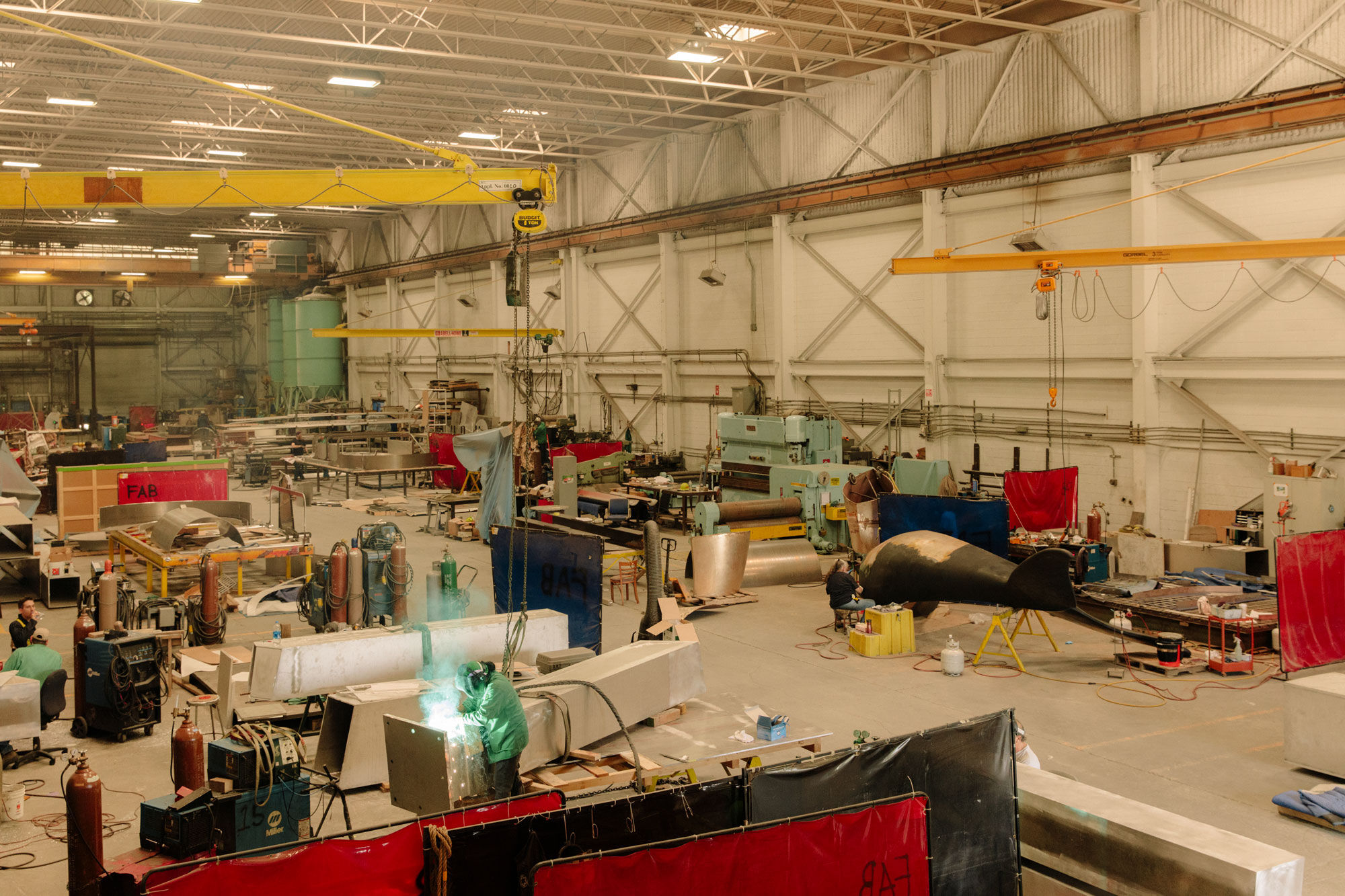
View inside of the Polich Tallix art foundry, where works by Joel Shapiro and Jim Sardonis are in different stages of production. Photo by Ricky Rhodes for Artsy.
Advertisement
Polich Tallix represents a side of the art world that the public never sees and rarely hears about. Yet we’re familiar with the work made here—public artworks and finely crafted sculptures that populate our favorite museums, parks, plazas, and other public spaces. This particular foundry is responsible for some artworks that are so famous, they’ve already entered the art-historical canon—like the silver bunny that made
the world’s most expensive living artist; Maman (2003),
’s iconic spider that’s over 30 feet tall; and Milan’s 24-foot-tall bronze horse designed by
. We don’t typically question how these artworks come to be. The beating heart of these veritable art factories are their employees. Not just fabrication experts, many are artists in their own right, who take pride in working behind the scenes to execute wondrous creations.
the world’s most expensive living artist; Maman (2003),
’s iconic spider that’s over 30 feet tall; and Milan’s 24-foot-tall bronze horse designed by
. We don’t typically question how these artworks come to be. The beating heart of these veritable art factories are their employees. Not just fabrication experts, many are artists in their own right, who take pride in working behind the scenes to execute wondrous creations.
Rosemary Rednour was diligently covering the surface of one of Sardonis’s acquatic creatures with a velvety, greenish-black pigment. A patinist, Rednour is charged with applying the finishing touches to a sculpture—the artist’s desired patina or finish. Her tools of choice are a paintbrush to daub on solvents, and a torch to accelerate chemical reactions.
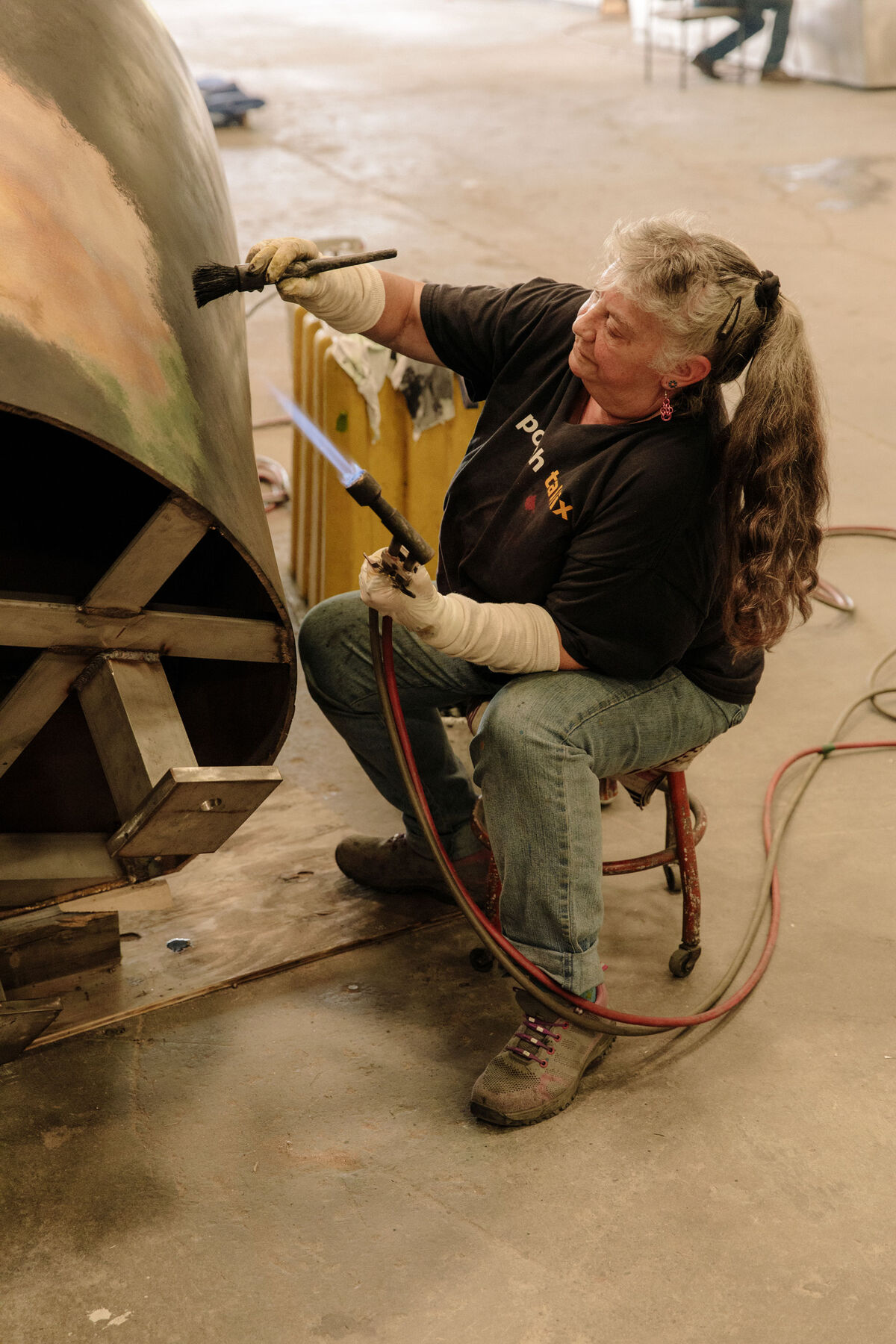
Rosemary Rednour is applying hot patina to a sculpture by Jim Sardonis. Photo by Ricky Rhodes for Artsy.
For this whale sculpture, Rednour explained, she created a sample of black pigment for the artist, who then asked that she add a bit of green into the mix. She often receives feedback like this, leading her to do some guesswork and rely on her instincts, in hopes that the artist will ultimately be pleased. “It’s very satisfying when I guess right,” she told me. “I always tell [the artists] I can read their minds, and that just messes with them,” she chuckled.
Over the years, highly ambitious artists, like Joel Shapiro and Jeff Koons, have stretched the limits of what the foundry can do.
Advertisement
Rednour’s path into this work was roundabout. After studying engineering in college, she and her husband moved to Silicon Valley to get jobs in the electronics industry. Rednour worked alongside engineers and ascended to the supervisor level, running her own team. But after moving back home to the East Coast and starting a family, the couple moved around, chasing after well-paying jobs for a decade as various companies were bought and sold. When her son was going into first grade, Rednour applied for a job at IBM, only to find they were offering her an entry-level position, well below her expertise. So she left the industry. A job listing for Polich Tallix caught her eye in the newspaper, and despite her lack of artistic experience, she landed the role.

Portrait of Vicente Cardoso, PTX Craftsman. Photo by Ricky Rhodes for Artsy.
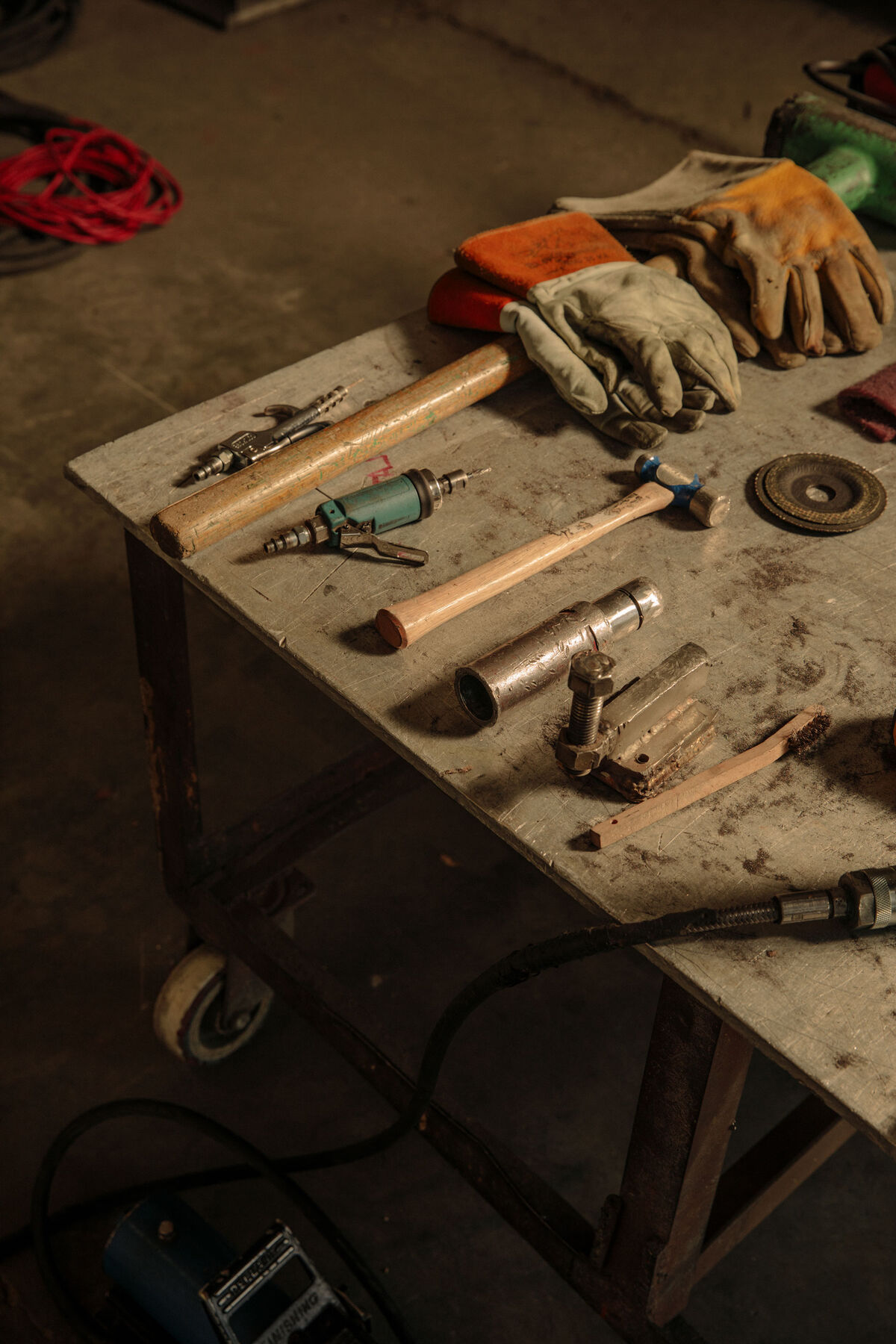
Finishing tools. Photo by Ricky Rhodes for Artsy.
Her studied hands have since added sheen and color to work by countless artists, from
to Koons and Eisenman. She stays abreast of the latest patina techniques and riffs on experts’ recipes to develop her own solutions. Rednour has also started her own art practice, making small sculptures and jewelry pieces with experimental patinas. She’s now one of several employees at the foundry who made their way into the business decades ago and stuck around, continually swept up by the endless creative problem-solving that the job requires.
to Koons and Eisenman. She stays abreast of the latest patina techniques and riffs on experts’ recipes to develop her own solutions. Rednour has also started her own art practice, making small sculptures and jewelry pieces with experimental patinas. She’s now one of several employees at the foundry who made their way into the business decades ago and stuck around, continually swept up by the endless creative problem-solving that the job requires.
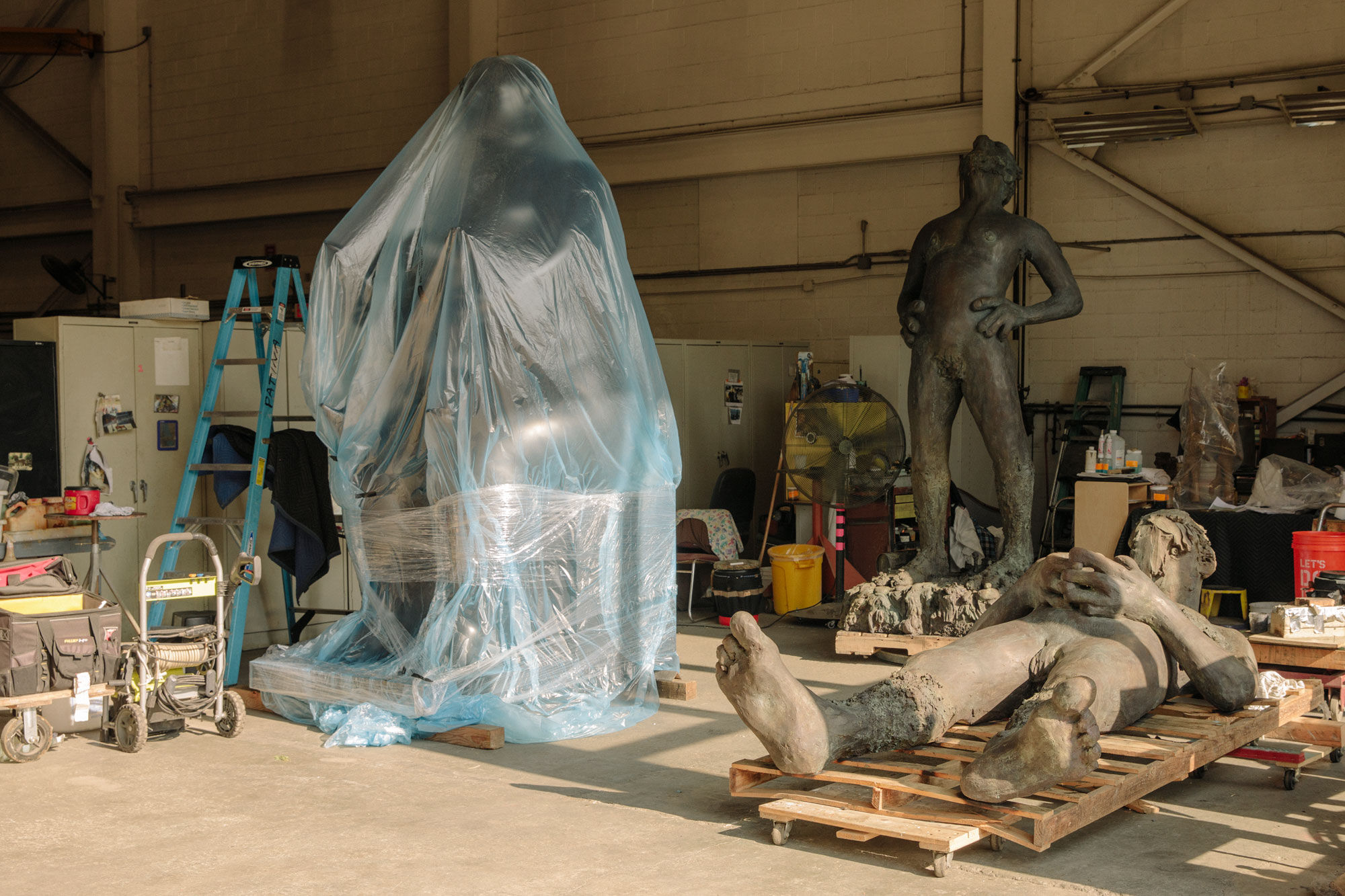
Works by Fernando Botero and Nicole Eisenman in the Polich Tallix art foundry. Photo by Ricky Rhodes for Artsy.
Foundries like Polich Tallix operate around the world to take artists’ grand ideas from renderings or sketches to full-blown artworks. Few artists have the space, equipment, or resources to execute such ambitious sculptures in their own studios. So when they receive commissions for public artworks—or just simply want to make casts of their sculptures in materials like bronze, steel, or iron—they call upon the services of a foundry or a fabrication studio. A foundry typically revolves around casting metal, while fabrication studios offer a greater range of services, such as work in glass and textiles, as well as architectural projects.
Dick Polich founded Polich Tallix in 2006, but his days of running foundries in the Hudson Valley date back to the late 1960s. He started out at a fortuitous moment when
and
thrived, and artworks began to rely on ideas and precise forms, instead of an artist’s technical skills.
and
thrived, and artworks began to rely on ideas and precise forms, instead of an artist’s technical skills.
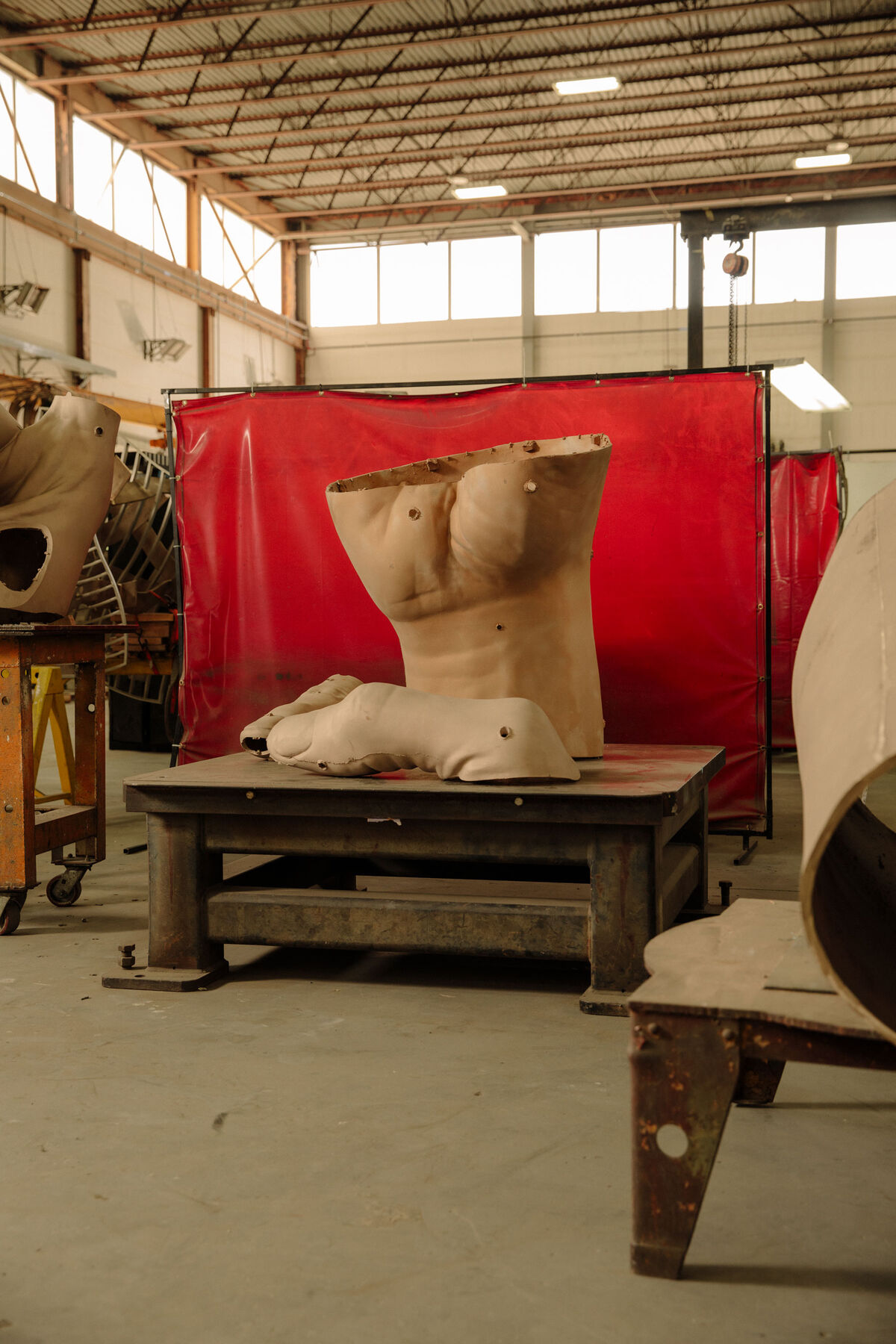
Artwork © Hank Willis Thomas, Unity, 2019, an original work commissioned by the City of New York Department of Cultural Affairs Percent for Art Program, the Department of Transportation and the Department of Design and Construction. Photo by Ricky Rhodes for Artsy.
Over the years, the business transitioned—from Tallix to Polich Art Works to Polich Tallix—as Polich took on new business partners and collaborators. The operations moved from Peekskill to Beacon to the current site in Rock Tavern, New York; it now has a staff of around 100 people. Over time, the foundry racked up a glittering roster of artist clients:
,
,
,
,
—the list goes on. Plus, it took on high-profile projects, ranging from the Korean War Veterans Memorial in Washington, D.C., to the gleaming gold Oscar statuettes.
,
,
,
,
—the list goes on. Plus, it took on high-profile projects, ranging from the Korean War Veterans Memorial in Washington, D.C., to the gleaming gold Oscar statuettes.
Polich started out at a fortuitous moment, when Conceptual art and Minimalism thrived, and artworks began to rely on ideas and precise forms, instead of an artist’s technical skills.
Polich Tallix entered a new chapter this past April, when Dick Polich retired. Approaching his nineties, Polich was looking to sell the business, so he reached out to the Australian fabrication company UAP, which has sprawling warehouses in Brisbane and Shanghai. With a staff of around 200 people, the company works on massive projects with prominent artists like
and
, as well as architects and designers. Previously, UAP’s only American manufacturing took place in a small warehouse in Long Island City. So last October, when Polich called the company up with the opportunity to take over his established foundry in the New York City vicinity, UAP jumped at the chance.
and
, as well as architects and designers. Previously, UAP’s only American manufacturing took place in a small warehouse in Long Island City. So last October, when Polich called the company up with the opportunity to take over his established foundry in the New York City vicinity, UAP jumped at the chance.

Portrait of Salvador Guzman, PTX Craftsman. Photo by Ricky Rhodes for Artsy.
“When he called, I was pretty blown away that they would actually call us,” said Ben Tait, president of UAP North America. “I always held them in this light of these guys are what we want to be in years to come, to hold that sort of reputation,” he recalled. Since the deal was finalized in April, UAP has already brought its own artist clients into the Hudson Valley space and the company has plans to diversify its offerings.
“UAP is not material or process driven, we go with the artist wherever they want to go,” Tait said. As a result, he continued, the company has worked in a broad range of materials and methodologies, which has helped it grow. “Whereas these guys have grown up being a foundry,” Tait continued. “That’s their wheelhouse and they’re amazing at it, but they’re fairly constrained, so we have to expand what their workforce does.” Tait is particularly bullish about the existing team, and plans to keep every staff member. “One of the things we’re most blown away by is the people and the talent,” he recalled.
The entry of UAP has left some of the staff jittery, while others are optimistic. Morgan Donahue, who is a sand molder and has been in this line of work for 37 years, is in the latter camp. “They’re not buying us for that half-broken welder in the corner,” he told his colleagues. “They’re buying us because of what you can do with that half-broken welder in the corner. They want the floor, they want our experience.”
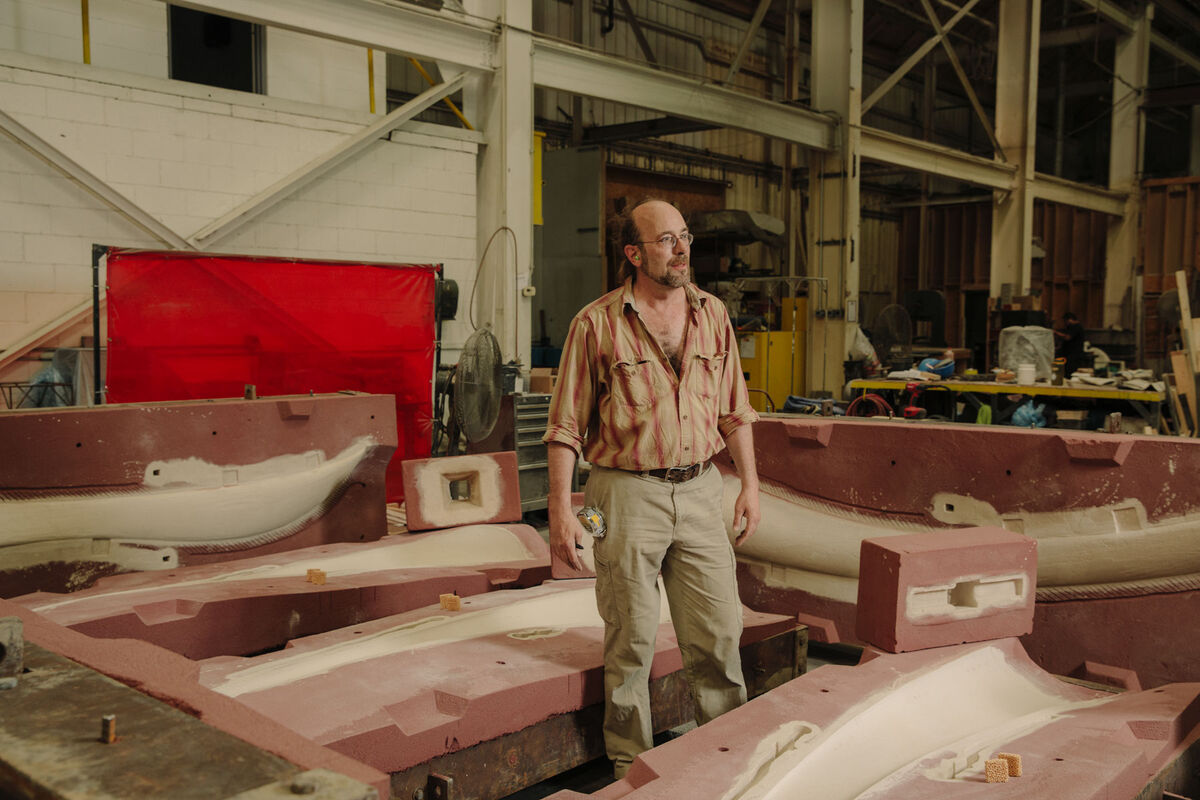
Sand molder Morgan Donahue, surrounded by sand molds for a sculpture by Christopher Curtis. Photo by Ricky Rhodes for Artsy.
Donahue started working at the foundry about 8 years ago; before it closed, he worked at Tallix in Beacon for 20 years. He got into the business after working as a photographer following his time in college. One day, while shooting photos of an artist, he realized he wanted to learn to be a sculptor. “I always dabbled in clay, stained glass, drawing, painting, whatever,” Donahue recalled. “I needed a gig and wanted to learn how to sculpt, so I applied for about a year until I finally wore them down, and they started teaching me.”
Sand casting is one of two casting methods that Polich Tallix offers; the other is lost-wax casting. Sand casting involves compressing sand around a sculpture or prototype to create an impression that will become a mold. Donahue spends his days building these carefully tailored molds; his work begins when an artist delivers the piece they want to cast. On the day we met, Donahue was working on a straightforward mold for a sculpture resembling a giant bone by artist
.
.
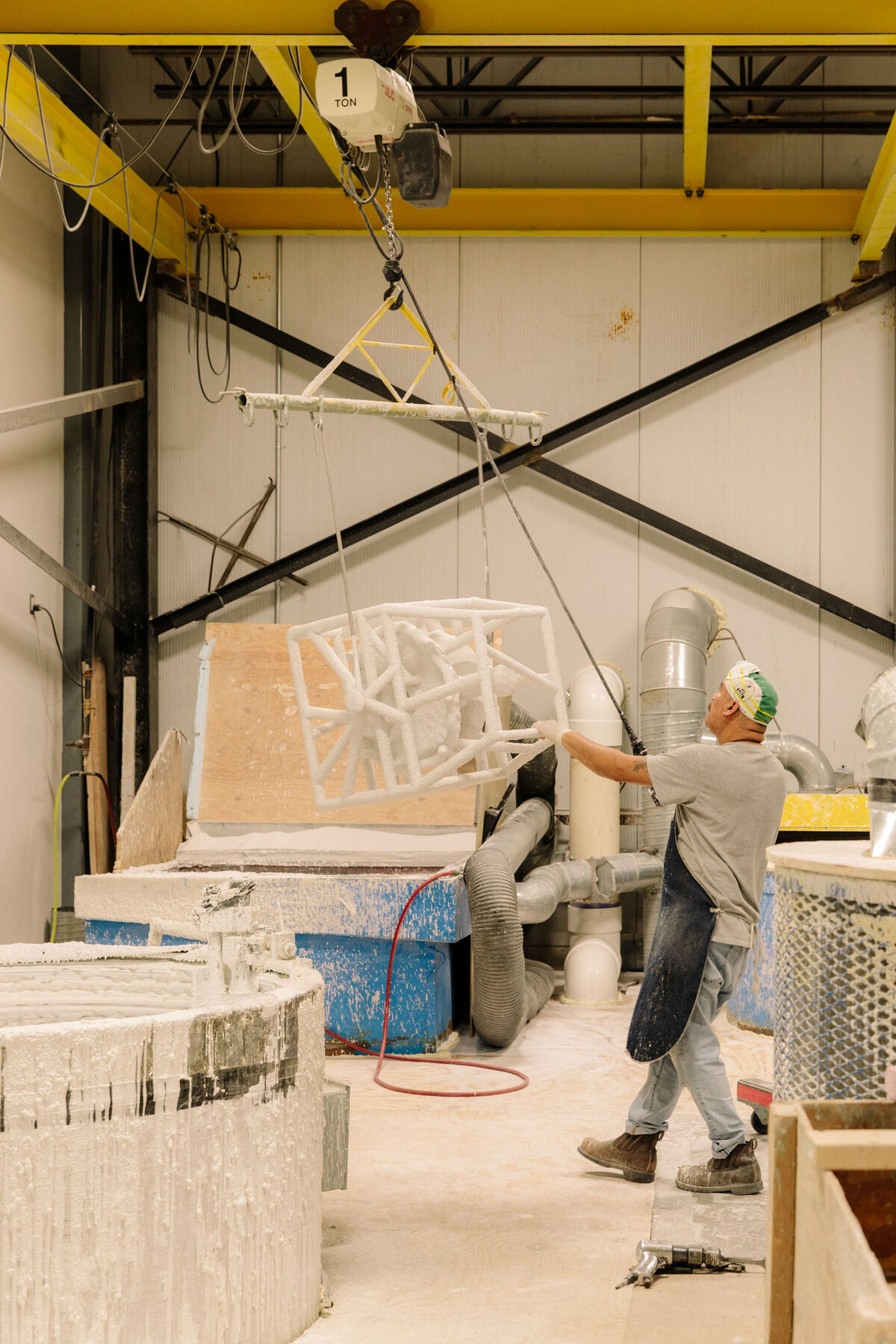
PTX Craftsman, Miguel Lucero, dipping wax to build ceramic shell for casting. Photo by Ricky Rhodes for Artsy.
“Sand is a one-shot deal,” Donahue explained, noting that it’s mostly used to create limited editions and one-of-a-kind sculptures. In the casting process, the mold gets destroyed, so making a few casts of the same sculpture means going through the entire, days-long process again and again. “I think the most of anything I’ve ever made was 12
,” Donahue reflected, “and that was over the course of about 10 or 12 years.”
,” Donahue reflected, “and that was over the course of about 10 or 12 years.”
Artists are involved in the work that happens at Polich Tallix to varying degrees. While some might drop off a work and return only when it’s finished, others prefer to be involved in the process and manage its every step. Donahue tends to work without much oversight; he develops a plan, presents it to his supervisor, and gets to work.
In lost-wax casting, the sculpture or prototype is molded, then cast in wax; afterwards, that wax replica is dipped in a ceramic slurry, which forms a shell. Once the shell is heated and hardens, the wax melts out, and molten metal can be poured in.
At the Polich Tallix wax department, Laura Gunsch focuses on gating—the irrigation system that allows wax to leave the mold, and molten metal to enter it. If not done correctly, the gating can negatively affect four other departments that will work on the sculpture.
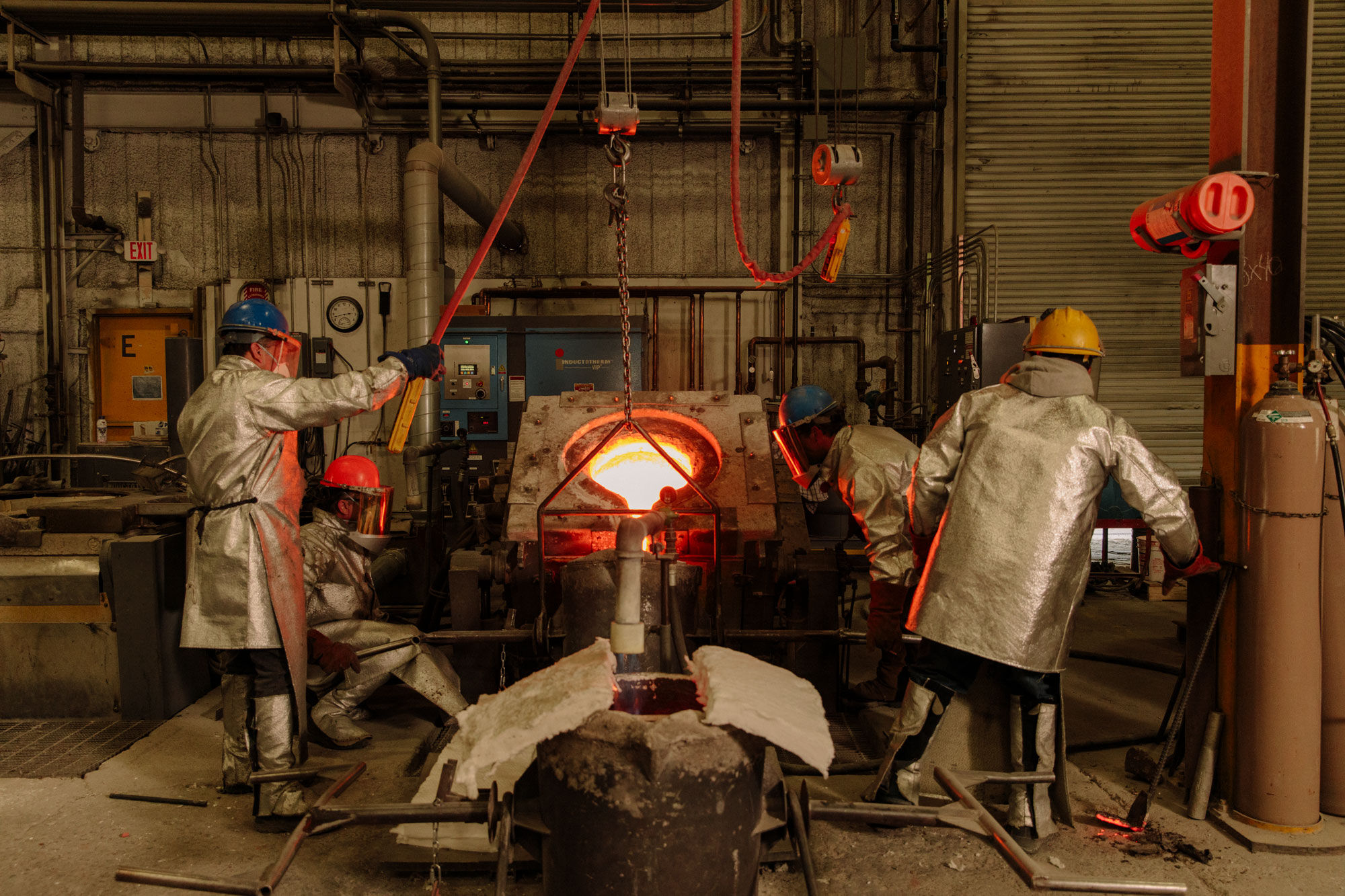
PTX foundrymen pouring molten metal into a crucible. Photo by Ricky Rhodes for Artsy.
The wax department occupies a narrow room off to one side of the main floor. The brightly lit space is lively with workers focused on deep-brown wax casts—structures that slightly resemble large, elaborate versions of chocolate Easter rabbits. Filled with all manner of tools, the space, more than any other part of the foundry, recalls the close quarters of an artist’s studio.
The work day begins between 6:30 and 8:00 a.m., depending on an employee’s preferences. “I usually just start by looking at my work, setting up for the day, laying out my tools, turning on my flame, adjusting my table, and that’s basically it,” Gunsch explained. The fabricators often listen to music, Gunsch told me, but she prefers podcasts.

Supplies for wax rework. Photo by Ricky Rhodes for Artsy.
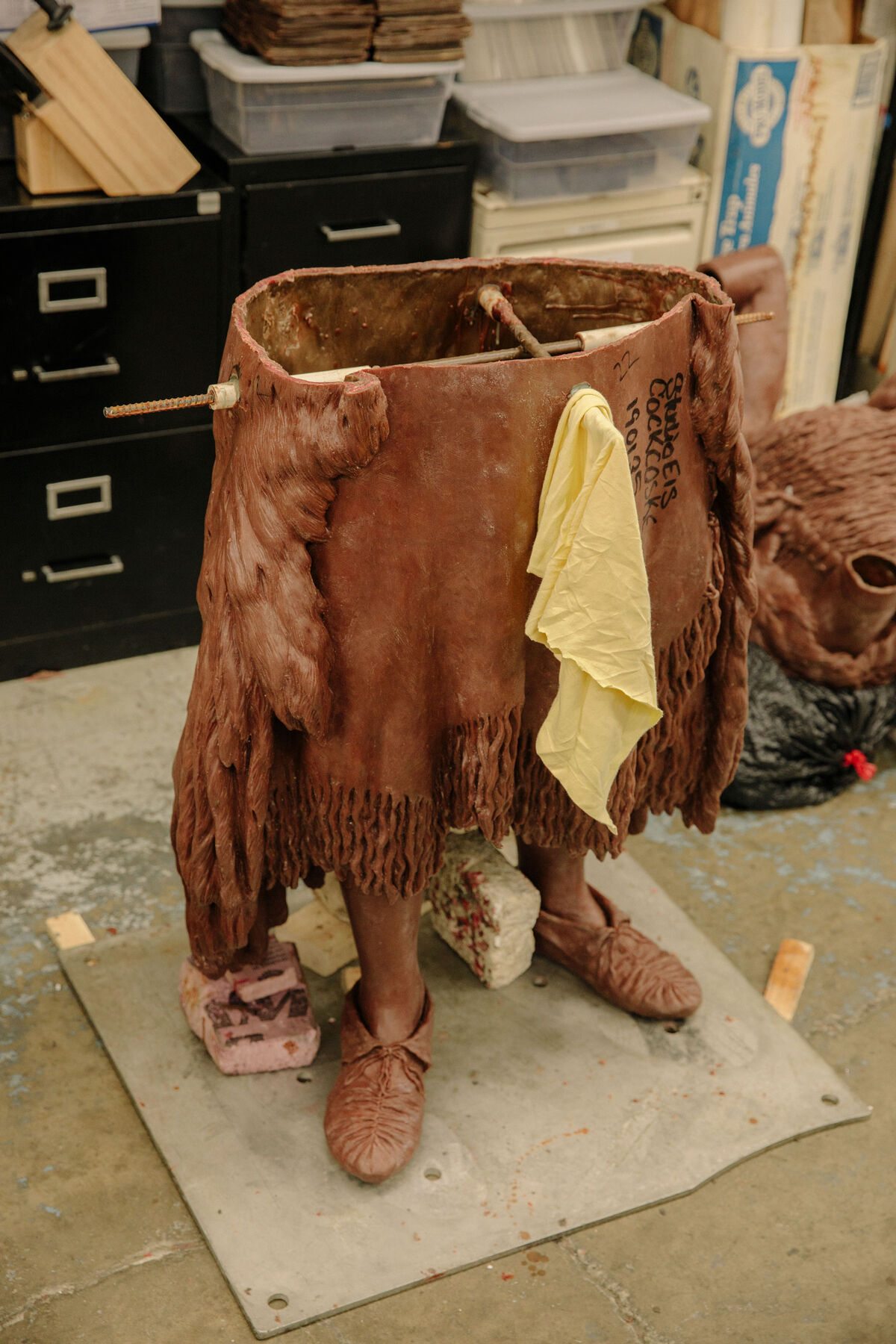
A sculpture in progress for the Virginia Women’s Memorial. Photo by Ricky Rhodes for Artsy.
Gunsch, too, got into the business around three decades ago, after hearing about the job through word of mouth. “I’m a lifer,” she said. “There’s a core group of us that, for whatever reason, we’ve decided to stick around.”
The job offers a lot of satisfaction, she reasoned—“whether it be your own personal satisfaction from a job well done, or that you’re part of making history when you work on, say, the Korean War Memorial.” That particular project, consisting of 13 steel soldiers in ponchos, was very memorable for her, due to the complexity and difficulty. But the work is also about the people, Gunsch added. “There’s a bunch of nuts here that, you know, it’s like your family.”
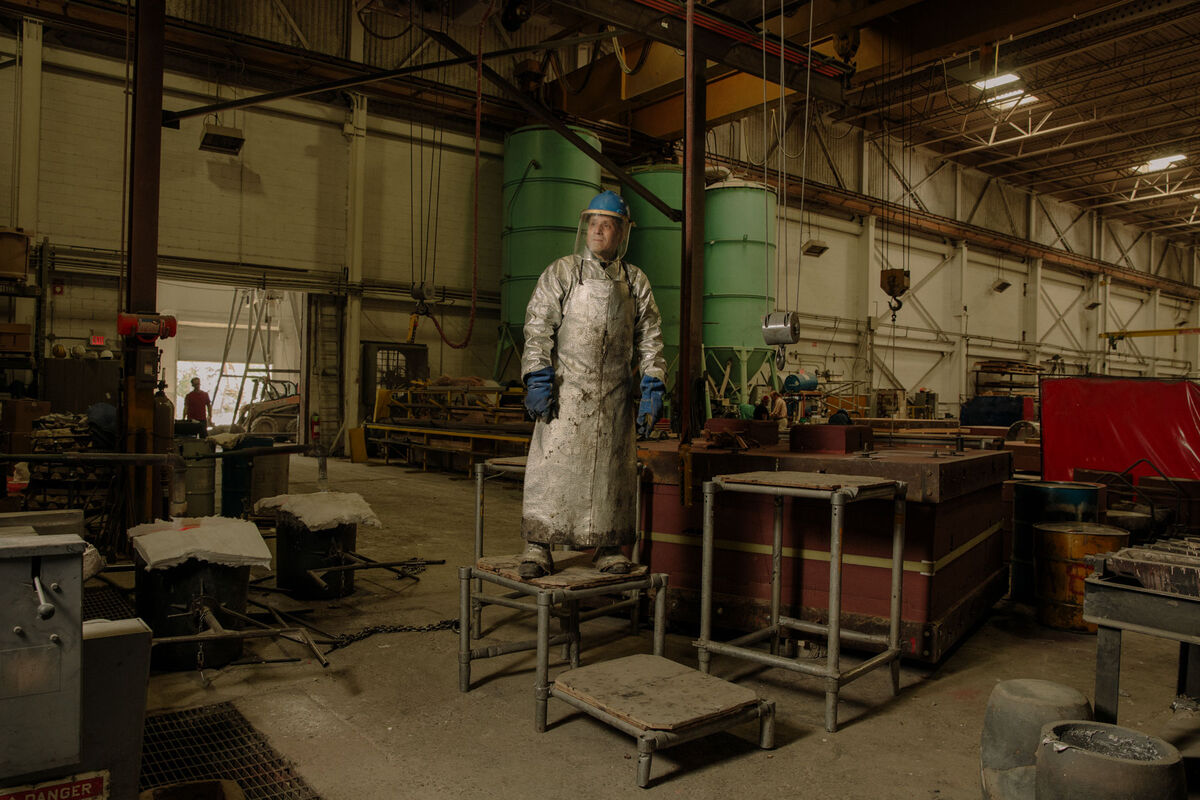
Portrait of Vicente Cardoso, PTX Craftsman. Photo by Ricky Rhodes for Artsy.
Once a mold is complete, it’s ready to be filled with molten metal. That afternoon, the foundry team—donning hard hats and matching silver jackets, aprons, and legwear—was doing a bronze pour for one of von Rydingsvard’s works. This happens at the far end of the warehouse, where large ovens heat the metal until it becomes a melty, fiery-red liquid. The team pours the metal into a crucible, then transports it to the mold. They carefully pour the molten metal into designated holes that allow it to flow through the gating system and into the mold. The piece cools overnight before being sent to “knockout,” where a crew uses jackhammers to break the mold and remove excess material from the sculpture. Afterwards, the piece gets sent to the finishing department.
Insun Kim is a metal finisher. When we met, she was working on a sculpture of Anne Frank, one of several realistic, figurative sculptures of women that populate the space. The works—female monuments designed by Studio EIS—are destined for the Virginia Women’s Monument in Richmond. Kim’s work involves welding together multiple parts of a piece, then polishing those seams and adding back in any texture that may have been lost. Ultimately, her job is to make sure the work matches the artist’s original intention. In this case, she’s focused on Frank’s hand; she holds the wax replica of the original prototype to make sure the finished piece will match.

Metal finisher Insun Kim is refining details on a sculpture of Anne Frank for Studio EIS. Photo by Ricky Rhodes for Artsy.
Kim worked at Tallix for 24 years before opening her own foundry, which she ran for 12 years. She closed it last year and returned to Polich Tallix in January. She prefers metalworking, which relates to her own art practice. In her studio at home, Kim makes sculptures from welding together hundreds of nails. Such work gets tedious, so she likes having a day job that offers some variety. “It’s a nice break, doing something like this,” she said, gesturing to the female sculptures. The week prior, she had worked on smoothing the surface of one of Sardonis’s whale tails; before that, she worked on “an aluminum cat lady,” a work by the
.
.
“Once we make it, it’s going to be there forever, so I like to make sure that I did as good a job as I could.”
For Kim, the best part is the lasting impact of the work. “This is kind of monumental, you know?” she offered. “Once we make it, it’s going to be there forever, so I like to make sure that I did as good a job as I could.”
Sculptures make their final stop at the patina department, where Rednour often meets them. She has “a million” color samples, but most clients stick to inconspicuous shades of brown, green, or black. There are some more creative opportunities, though, like when an artist asks for something to look as though it’s been “dug up from the ocean.”
Rednour enjoys the process of developing new recipes for patinas and wax—the latter is used for a final protective coating. To cover the shiny black surfaces of Botero sculptures, she’s been concocting a synthetic wax based on a recipe from the Getty Museum. “I’m on the search for the perfect wax,” she explained.
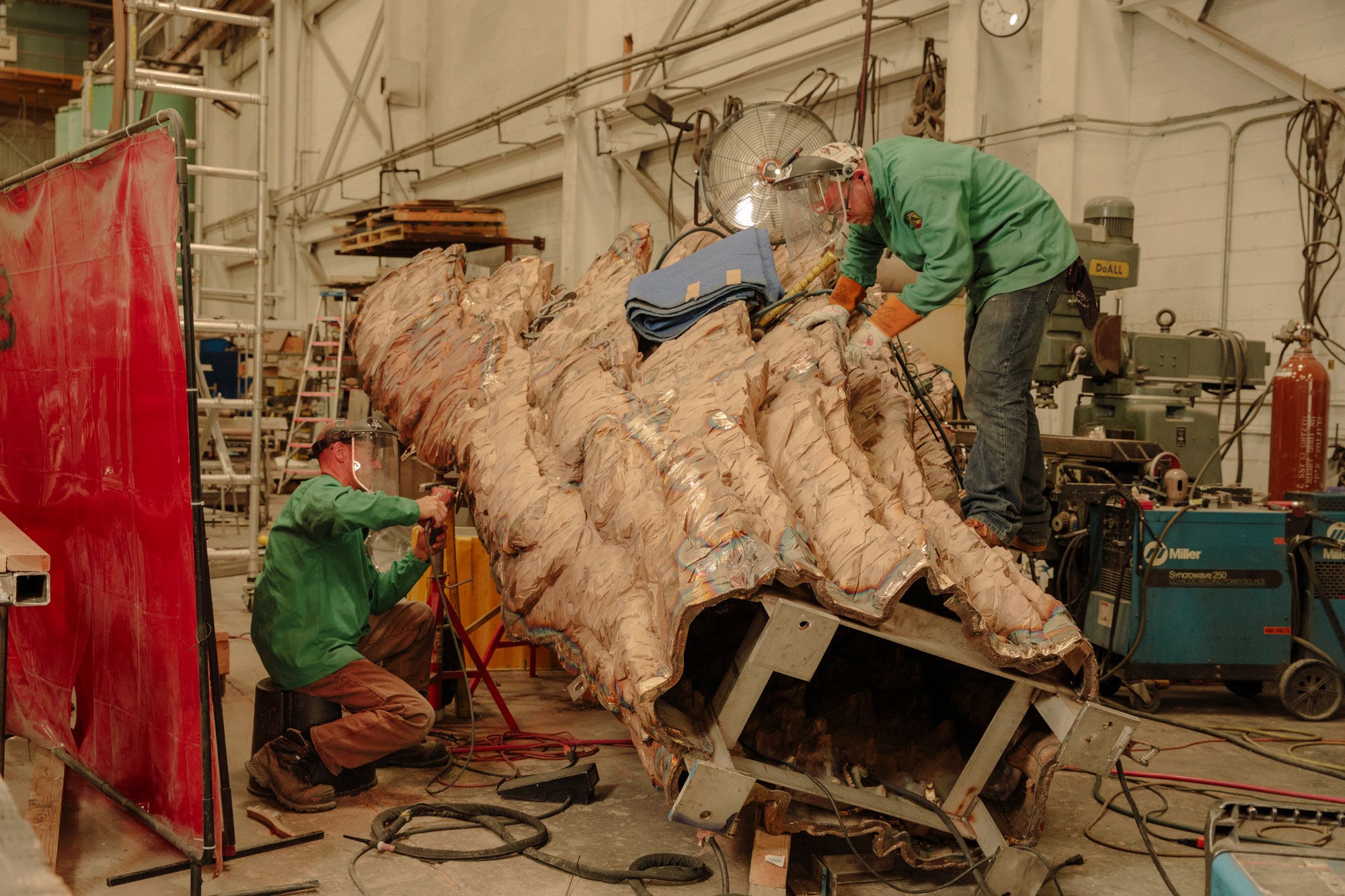
Craftsmen welding and finishing bronze casting for a work by Ursula von Rydingsvard. Photo by Ricky Rhodes for Artsy.
One of the most gratifying parts of the job is being able to collaborate with artists. She described scenarios where there’s a “push and pull” between herself and the artist; where she can help them become aware of the possibilities and directions their work can take. “That’s a really satisfying part of it, the interaction,” she said.
“All the other processes, as technically difficult as they are, are not allowed to give back anything other than what the artist gave them,” Rednour continued. “When it comes to patina, sometimes they haven’t even thought that far in the process.” Sometimes the original sculpture was made in clay, papier-mâché, or styrofoam, and that’s how the artist sees it. Then, when they see the bright, shiny metal of the unfinished sculpture, “they get confused and you have to rein it in,” she explained. “Sometimes what happens wasn’t even thought of in the beginning; you have a chance to make a different kind of difference.”
When Rednour’s son finished his master’s degree, he traveled through Europe visiting museums and taking pictures of the sculptures she’d worked on.
Artists come to trust Rednour. She walks over to a large piece by von Rydingsvard and points to her favorite section, covered in earthy greens, yellows, and reds. Von Rydingsvard, who is a frequent client, goes to the foundry to work on her own patinas with her assistant and Rednour. “She doesn’t really say what she wants, just what she doesn’t want,” Rednour said, noting that they don’t have an exact process, but rather a harmonious way of all working on the patina together.
In the early years, Rednour kept notebooks to track all of the art she’d patinated. Today, it can be found in art institutions around the world. She recalled that when her son finished his master’s degree in London, he traveled through Europe for a month, visiting museums and taking pictures of the sculptures she’d worked on. “He said, ‘I can go almost anywhere and find something that you worked on,’” she remembered. “That’s fun.”
Working with artists can be nerve-wracking, Rednour admitted; particularly in the present, when so much communication happens through emails and digital images—the back-and-forth can become frustrating. But over the years, she reflected, artists making technically challenging work, like Shapiro and Koons, have stretched the limits of what the foundry can do. “It’s kind of forcing you to be better,” she said, “and as much as it makes you crazy, you know you have to keep pushing and pushing.”
Ultimately, Polich Tallix is one giant, multifaceted artist studio. And while the big-name artists aren’t always around, there are always artists present.
From a tool cabinet, Rednour produced a catalog filled with images of her own artworks from over the years—like sculptures made from scrap metal covered in bright, swirling patinas. Before setting foot in the foundry, she’d only made a couple of artworks in her life. Upon entering this hive of creativity, with its many tools and processes, she hasn’t been able to stop. “That’s what happens when you work here,” she said.
Donahue has his own art practice in which he experiments with sand and the molding process that consumes him day after day. He estimated that all manner of artists and creatives—sculptors, photographers, glass blowers, woodworkers, ceramicists, jewelers, and more—have passed through the foundry over the years, drawn in by the creativity. Even those who don’t identify as artists—like Gunsch, who insists she’s an artisan—can’t help but try out the casting techniques. When you’re surrounded by so much art, it’s hard not to fall under creativity’s eternal spell.
Casey Lesser is Artsy’s Lead Editor, Contemporary Art and Creativity.